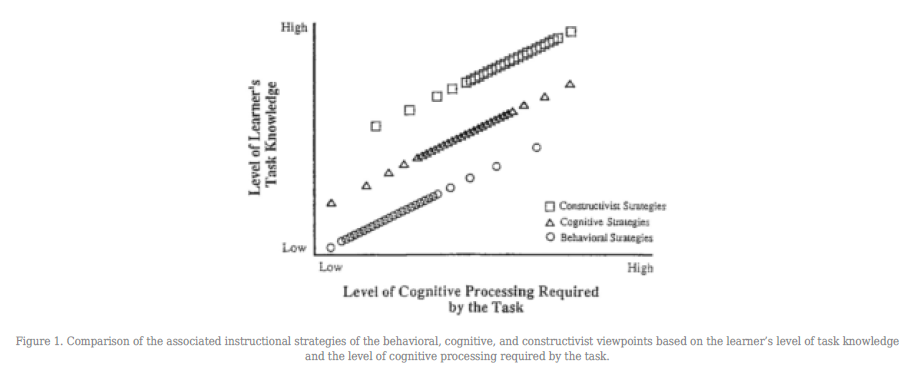In this post I’d like to share how I learned piano, and how it relates to the behavioral, cognitive, and constructivist approaches to learning.

As Maya mentioned in her post, the behavioral, cognitive, and constructivist approaches to learning fall on a continuum, which is also shown by Figure 1 from Ertmer & Newby (2013). Ertmer & Newby explain that this continuum ranges from low to high levels of learner task knowledge and cognitive processing required, with behavioral approaches typically occupying the lower end of the spectrum, and constructivist approaches typically occupying the higher end of the spectrum.
When I first started learning piano, I knew nothing about music, piano, or reading notes (low task knowledge), but the level that I would be expected to perform at was also quite low (low level of cognitive processing required). My teacher employed a method of teaching that could be described by behavioral methods, where given a stimulus (a musical note on a piece of paper), I would respond with the appropriate response (playing the correct note in the correct octave at the correct time for the correct duration on the piano keyboard. This was accomplished through practicing musical scales and playing simple songs with single note melodies and basic left hand accompaniment, and doing written practice exercises that could be described as a sort of ‘musical spelling bee’ to help me learn how to read music. Establishing the foundations of music theory and practical experience through repetition also helped me gain muscle memory, and ultimately helped me learn piano.
After I was comfortable reading music and more familiar with how to move my fingers and position my body to depress the keys on the piano to play simple songs, we moved into a more cognitive approach to learning, where new concepts were integrated with my foundational knowledge and experience. For individual pieces, I would still use a behavioral method of practice and repetition in order to build muscle memory to learn specific pieces of music, but we added more complex harmonies, multi-note melodies, ornaments, new articulations and more expressive dynamics, and increasingly complex passages.
Finally, as I progressed further in my studies, I moved on to a more constructivist method. I used to think that there was a single way to play the music I was given: exactly as it is written on the page. At this stage in learning piano, I realized I could integrate all of my theoretical knowledge of music and music history and include my own perceptions and expression into the music, and because I had spent the countless hours practicing pieces by repetition (behavioral approach), I had the technical ability to execute whatever came to mind. There are a million different ways that a million different people could interpret the same piece of sheet music, and that is what makes music beautiful.
References:
Ertmer, P. A., & Newby, T. J. (2013). Behaviorism, cognitivism, constructivism: Comparing critical features from an instructional design perspective. Performance Improvement Quarterly, 26(2), 43-71.